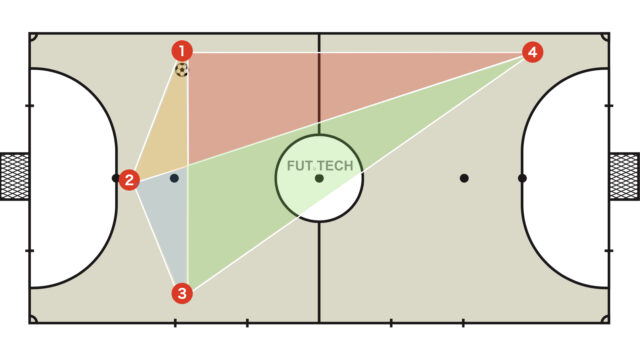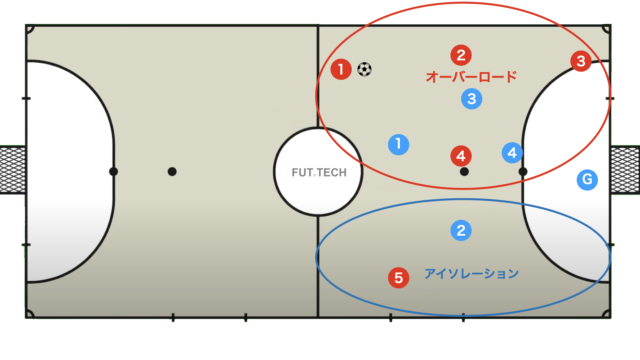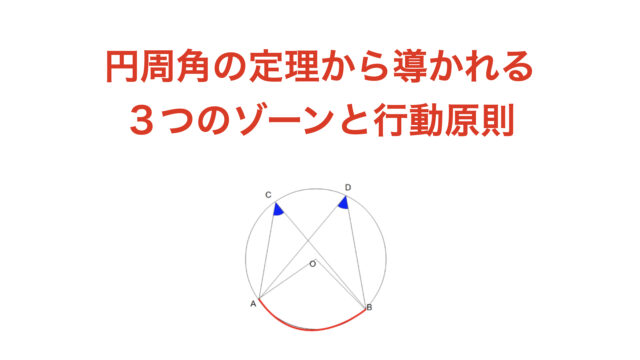Did you know that the names of positions in soccer and futsal are different?
Futsal positions are classified into the following four categories.
- ピヴォ(PIVO)
- アラ(ALA)
- フィクソ(FIXO)
- ゴレイロ(GOLEIRO)
In this article, we will briefly explain the names, roles, and characteristics of futsal positions.
Futsal Position ① The Frontline PIVO
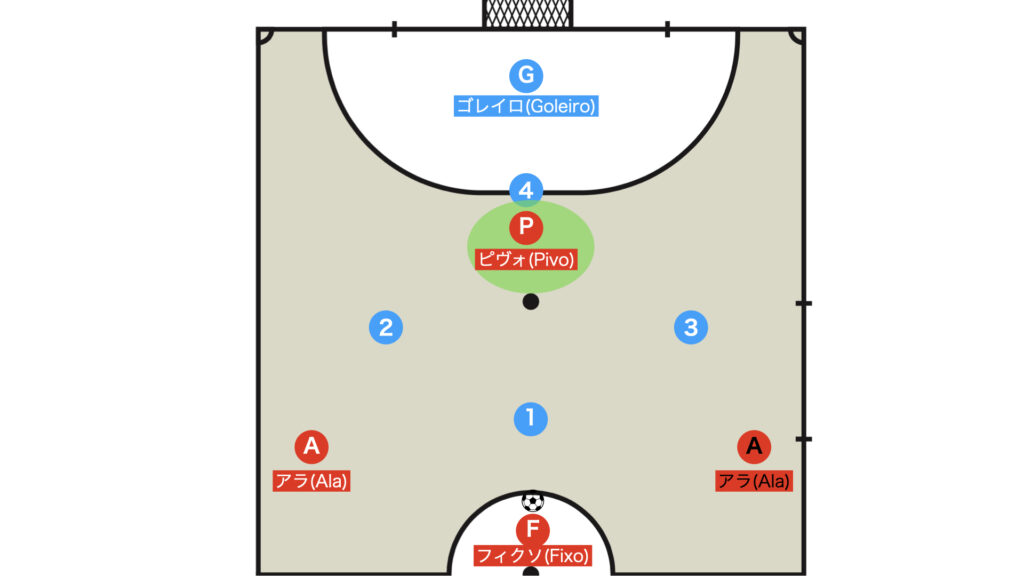
PIVO means “axis, center, forefront” in Portuguese, and it is positioned at the very front of the field.
Receive the ball while shielding the opponent and then take shots or pass to teammates – playing as the initiator of the attack is required.
There are two main types: the “static PIVO”, which plays by staying in the center while shielding the opponent, and the “dynamic PIVO”, which roams widely across the pitch, playing from the sides and lower positions.
Additionally, there is a tactic called the false PIVO, where a player feigns being the PIVO but drops back to the second line, thereby creating space on the opposite side and providing support between the lines.
There is also an article that provides a detailed explanation about futsal’s PIVO, so if you’re interested, please give it a read.
Below are three key characteristics of the PIVO.
PIVO Feature ①: Ability to Play While Shielding the Opponent
Positioned at the frontline, the PIVO is the field player who engages in the most physical contact.
Even while shielding an opponent, it is essential to maintain possession without losing the ball.
PIVO Feature ②: Ability to Turn
The most common scoring pattern for a PIVO is a turnaround shot after shielding the opponent.
The ability to transition from a turn into a shot is one of the criteria for an excellent PIVO.
PIVO Feature ③: Finishing Ability
One of the crucial tasks of a PIVO is to score goals.
Whether shielding an opponent or facing forward, the ability to deliver powerful and precise shots can be a major asset to the team.
Futsal Position ②: The ALA on the Side
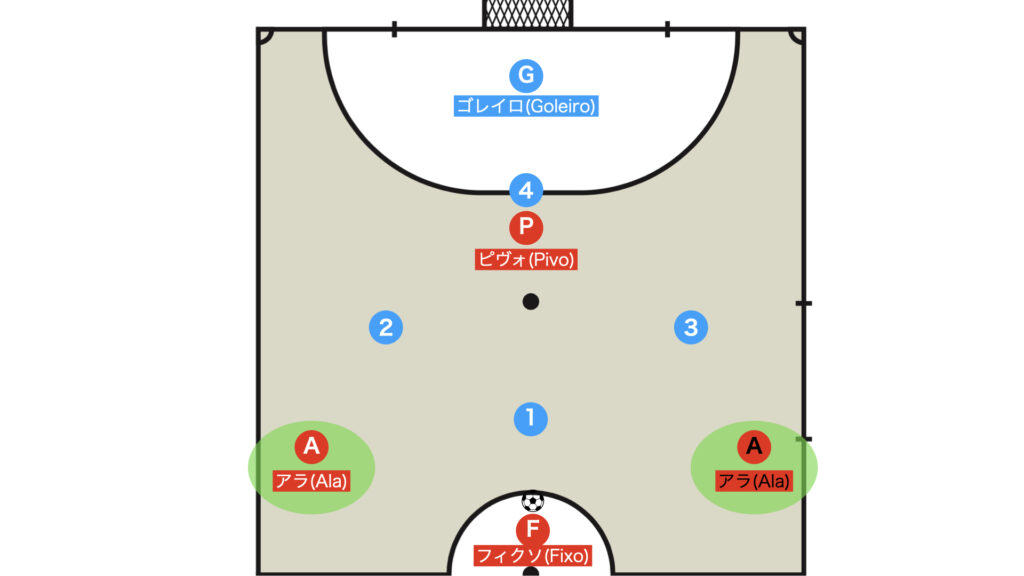
ALA means “side” in Portuguese.
There are various types of ALA.
Some excel in initiating dribble attacks, others serve as the engine with abundant stamina running all over the pitch, and still others organize the game primarily through passing – each with distinct characteristics.
It is no exaggeration to say that the combination of ALAs can change the team’s style.
Players who primarily play as ALA but also perform PIVO-like roles are called “ALA-PIVO”, while more defensive players are referred to as “ALA-FIXO”.
Below are four key characteristics of the ALA.
ALA Feature ①: Establishing a Good Connection with the PIVO
Offensively, an ALA is expected to build a good connection with the PIVO, whether by delivering the ball to them or receiving it after the ball reaches the PIVO.
ALA Feature ②: One-on-One on the Side
One of the roles of an ALA is to engage in a one-on-one dribble when in possession of the ball on the side.
If there is a player who excels in one-on-one situations, sometimes the ALA may deliberately isolate them (isolation) to make attacking easier.
ALA Feature ③: Excellent Tactical Awareness
Maintaining the overall balance of the team is an important role for the ALA.
It is desirable for an ALA to have the tactical vision to discern what is happening on the pitch and determine what should be done at any given moment.
ALA Feature ④: Quick Transition Between Offense and Defense
The speed of transitions – whether it is pressing and covering after losing the ball, or moving forward after regaining possession – is crucial.
Futsal Position ③: The FIXO in the Rear
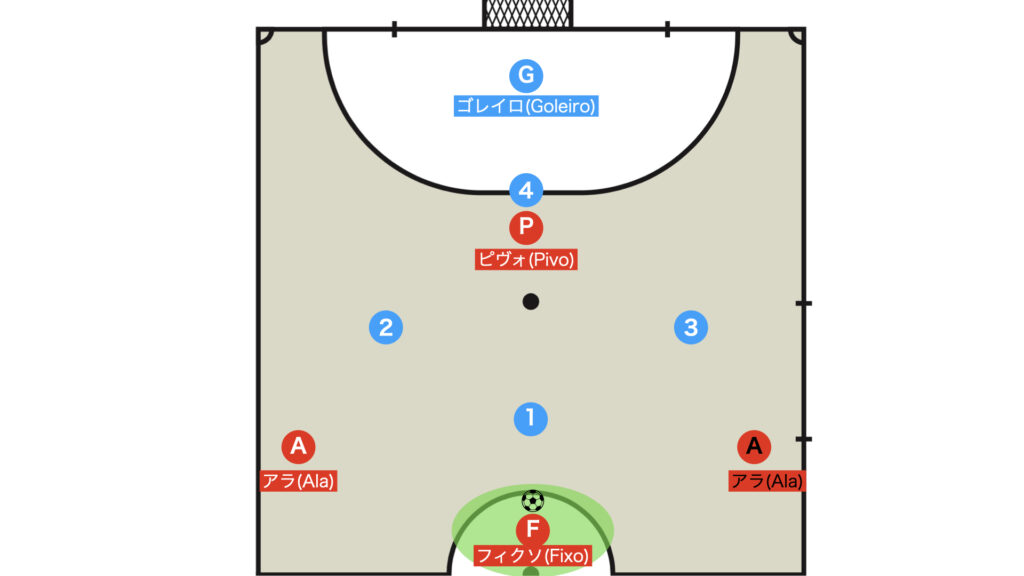
FIXO means “helmsman” in Portuguese.
Among field players, the FIXO, positioned at the very back, often matches up against the opponent’s PIVO.
To prevent the opposing PIVO from playing freely, excellent anticipation and strong one-on-one play are indispensable.
When in possession, the FIXO not only plays a crucial defensive role but also plays an important part in attack by setting the game’s rhythm with passing and taking shots from distance.
Below are four key characteristics of the FIXO.
FIXO Feature ①: Strong in Defense
The primary duty is to mark the PIVO, who initiates the attack.
Physical strength capable of competing with the PIVO and coordinated defense with the GOLEIRO are absolute necessities.
FIXO Feature ②: Well-Balanced Between Offense and Defense
Since the FIXO is positioned at the very back of the field, they must make situational judgments, deciding when to move forward or stay back while monitoring the overall balance and flow of the game.
FIXO Feature ③: Capable of Delivering Initiating Passes
When holding the ball from a lower position, the FIXO also serves as the playmaker.
If the FIXO can deliver a vertical pass to the frontline PIVO, it can create scoring opportunities from a simple setup.
FIXO Feature ④: Capable of Taking Middle-Range Shots
Positioned at the rear, the FIXO is relatively less marked.
If they can take a shot from a distance when in possession, it can diversify the team’s attacking options.
Futsal Position ④: The GOLEIRO, Guardian of the Goal
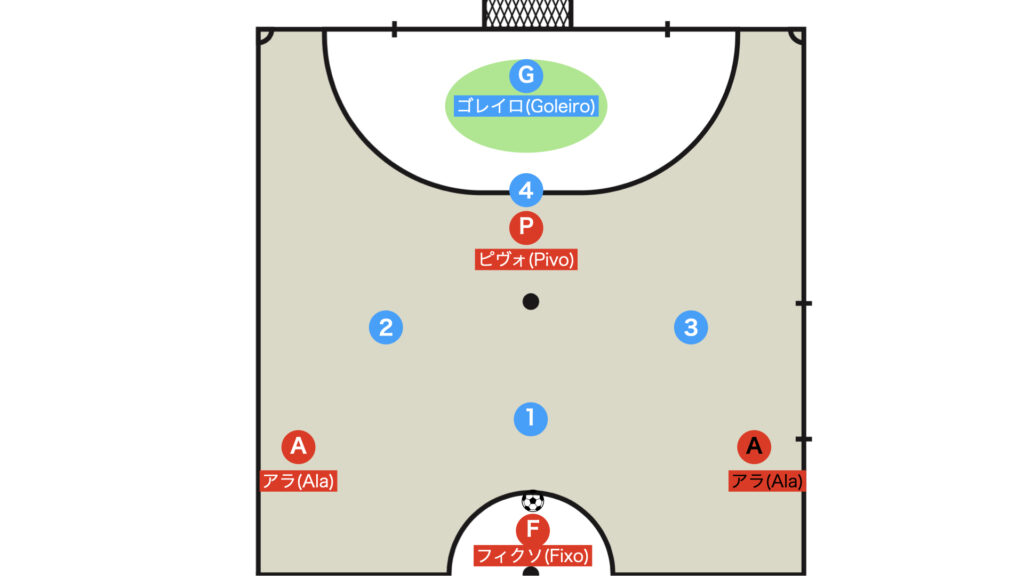
GOLEIRO means “goalkeeper” in Portuguese.
Just like a soccer goalkeeper, the main job of a futsal GOLEIRO is to stop the opponent’s shots.
At the top level, it is said that the GOLEIRO can decide 50% of the outcome of a match.
Moreover, the GOLEIRO is often involved in offensive plays through throws and feeds, and it is not uncommon for them to deliver a pass that leads to a goal.
They are also required to step out of the penalty area to provide covering support.
Sometimes, by joining the attack (power play), the GOLEIRO may even score a goal.
Below are four key characteristics of the GOLEIRO.
GOLEIRO Feature ①: Stops Shots
Above all, a GOLEIRO is expected to stop shots.
By taking the correct positioning and using not only their hands but also their feet, they stop incoming shots.
GOLEIRO Feature ②: Gets Teammates Moving
A GOLEIRO must coach their teammates to improve the chances of stopping shots.
To provide effective coaching, a deep understanding of futsal tactics and experience as a GOLEIRO are required.
GOLEIRO Feature ③: Acts as the Starting Point for Attacks
For a GOLEIRO, the ability to deliver accurate throws and feeds is extremely important.
In particular, a throw after catching an opponent’s shot can often lead to a counterattack.
Some teams feature a GOLEIRO who joins the attack during kick-ins.
GOLEIRO Feature ④: Capable of Covering
When necessary, they step out of the penalty area to provide covering support.
Even at times other than during shots, they must remain vigilant and make accurate decisions.
Summary: Let’s Get to Know Futsal Positions
This time, we introduced the four futsal positions (PIVO, ALA, FIXO, GOLEIRO).
Since the names of the positions are always used when discussing futsal tactics, if you haven’t memorized them yet, be sure to do so.
In this article, we have attached an image of the positions in the most popular formation in futsal, the 3-1 (3-0-1) formation; however, since roles (positions) change in other formations, if you have the time, please consider it.
Also, playing in a position that suits you is very important for achieving high performance, so initially, try various positions and find the one that best fits you.
Parts of this article were quoted from “Futsal Tactics Training Design” by former Shariker Osaka coach, Mr. Kigure.
It is a book that goes into detail about training methods and is very helpful for coaches, so if you’re interested, please give it a read.
Additionally, a video introducing futsal positions from the University of Tokyo Futsal Club (Professor Sanpachi) was also referenced.
They have posted a very informative video, so if you’re interested, please check it out.
Thank you very much for reading this article to the end.
If you found this article useful, please consider sharing it using the social media share buttons above.
We regularly share valuable insights on futsal tactics on Twitter, so if you haven’t followed us yet, we’d appreciate your support!
We are committed to raising the level of futsal in Japan by sharing high-quality information through discussions with individuals who have coaching experience in the F.League and overseas.
If you have any questions or notice any mistakes, feel free to leave a comment below.
We update our articles regularly, so if you’d like to keep reading, please bookmark our site or search for “FutTech”!
